
pressurized. Do not construe this as a defect.
2. The hose has not been twisted (check the
However, if the bubbles persist in forming at a
lay line).
steady rate at any particular point on the hose,
3. The circumferential chalk line on the hose
reject the assembly.
next to the coupling has been drawn before
the hydrostatic test.
4. The internal spring (if installed) is evenly
Installation of Flexible
spaced and flat against the inner liner.
Hose Assemblies
Ensure a gap exists between one of the end
fittings and the end of the spring.
After completion of tests, proceed as
follows:
Hydrostatic Test
1. Install as soon as possible.
Upon completion of visual inspection,
2. Do not leave the hose assembly around on
hydrostatically shop test the hose assembly with
decks or on docks where they can be
fresh water. For each style and size hose, test the
subjected to any form of abuse.
pressure to ensure that it is twice the maximum
allowable pressure shown in chapter 505 of Naval
3. Make up hose assemblies as late as
Ships' Technical Manual. When you test pressure,
possible during the availability schedule to
hold for not more than 5 minutes nor less than
minimize the chances of damage while the
60 seconds. When test pressure is reached, visually
ship is being overhauled.
inspect the hose assembly for the following
defects:
4. Install plastic dust caps, plugs, or tape ends
to protect threaded areas until the hose
1. Leaks or signs of weakness
assembly is installed.
2. Twisting of the hose (this indicates that
some twist existed before pressure was
When installing flexible base connections,
applied)
observe the following requirements:
3. Slippage of the hose out of the coupling
(a circumferential chalk line can help
1. Ensure each leg of hose is free of twist
determine this)
between end fittings.
2. Ensure the fixed piping near the flexible
If any of the above occurs, reject the assembly.
configuration is properly supported so that
it does not vibrate from the resiliently
mounted equipment.
CAUTION
3. Ensure the configurations are clear of all
surrounding structures and remain so when
Do not confuse hose elongation under
resiliently mounted equipment moves
pressure with coupling slippage. If the
through its maximum excursion under
chalk line returns to near its original
shock.
position, no slippage has occurred and the
assembly is satisfactory. If there is any
4. Locate flexible connection as close as
doubt, perform a second test. If doubt
possible to the sound-mounted unit.
persists after the second test, reject the
assembly.
5. Support the free elbow of the configuration
with an approved pipe hanger so as not to
sag or otherwise unduly stress or distort the
Air Test
configuration.
6. Do not appreciably change the alignment
Hose assemblies intended for gas or air
of the hose configuration between the
service must also be tested with air or nitrogen
unpressurized and pressurized conditions.
at 100 psi and the assembly immersed in water.
If you do, you could cause misalignment
Random bubbles may appear over the hose and
or improper support at the fixed end.
in the fitting area when the assembly is first
6-27

